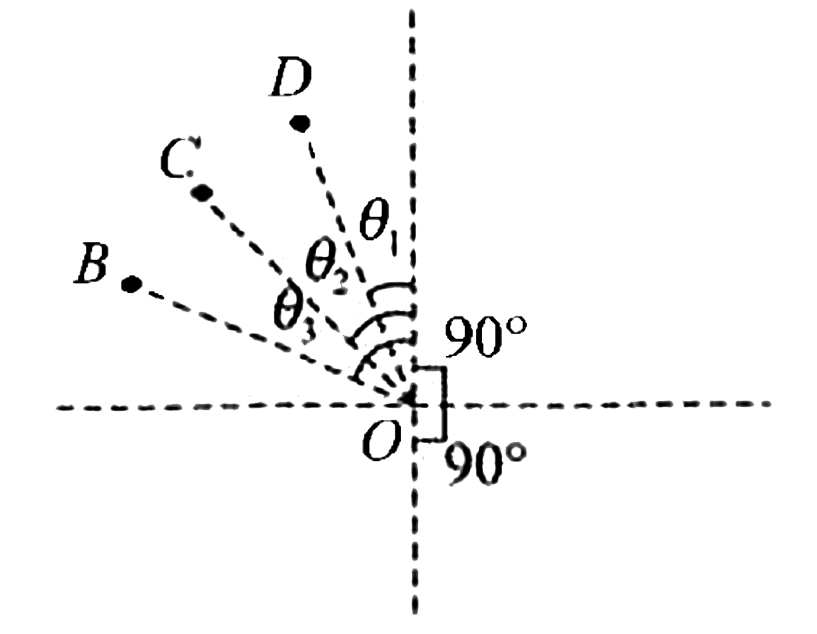For scattering by an inverse square field (such as that produced by a charged nucleus in Rutherford's model), the relation between impact parameter b and the scattering angle θ is given by,
b=Ze2cotθ/24πε0(12mv2)
What is the impact parameter at which the scattering angle is 90∘ for Z = 79 and initial energy equal to 10MeV ?
To find the impact parameter b at which the scattering angle θ is 90∘ for Z=79 and an initial energy of 10MeV, we will follow these steps:
Step 1: Write down the formula for impact parameter
The relation between the impact parameter b and the scattering angle θ is given by:
b=Ze2cot(θ/2)4πϵ0(12mv2)
Step 2: Substitute the values for θ
Since θ=90∘, we calculate cot(90∘/2)=cot(45∘)=1. Thus, the equation simplifies to:
b=Ze24πϵ0(12mv2)
Step 3: Convert the energy from MeV to Joules
The initial energy E is given as 10MeV. We convert this to Joules:
E=10MeV=10×1.6×10−13J=1.6×10−12J
Step 4: Relate energy to velocity
The kinetic energy E is related to the mass m and velocity v by the equation:
E=12mv2⟹v2=2Em
Assuming the mass m of the alpha particle (which is approximately 4×1.67×10−27kg):
m≈6.68×10−27kg
Step 5: Substitute values into the equation for b
Now substituting the values into the equation for b:
b=79×(1.6×10−19)24π(9×109)(12×6.68×10−27×2×1.6×10−126.68×10−27)
Step 6: Simplify and calculate
Calculating the denominator:
12mv2=E=1.6×10−12J
Thus, the equation for b becomes:
b=79×(1.6×10−19)24π(9×109)×1.6×10−12
Step 7: Final calculation
Calculating the values:
1. (1.6×10−19)2=2.56×10−38
2. 4π(9×109)×1.6×10−12=4×3.14×9×1.6×10−3≈1.44×10−2
Now substituting these back into the equation:
b=79×2.56×10−381.44×10−2≈1.137×10−14m
Final Answer
Thus, the impact parameter b at which the scattering angle is 90∘ is approximately:
b≈1.137×10−14m
The relation between the impact parameter b and the scattering angle θ is given by:
b=Ze2cot(θ/2)4πϵ0(12mv2)
Since θ=90∘, we calculate cot(90∘/2)=cot(45∘)=1. Thus, the equation simplifies to:
b=Ze24πϵ0(12mv2)
The initial energy E is given as 10MeV. We convert this to Joules:
E=10MeV=10×1.6×10−13J=1.6×10−12J
The kinetic energy E is related to the mass m and velocity v by the equation:
E=12mv2⟹v2=2Em
Assuming the mass m of the alpha particle (which is approximately 4×1.67×10−27kg):
m≈6.68×10−27kg
Now substituting the values into the equation for b:
b=79×(1.6×10−19)24π(9×109)(12×6.68×10−27×2×1.6×10−126.68×10−27)
Calculating the denominator:
12mv2=E=1.6×10−12J
Thus, the equation for b becomes:
b=79×(1.6×10−19)24π(9×109)×1.6×10−12
Calculating the values:
1. (1.6×10−19)2=2.56×10−38
2. 4π(9×109)×1.6×10−12=4×3.14×9×1.6×10−3≈1.44×10−2
b=79×2.56×10−381.44×10−2≈1.137×10−14m
Thus, the impact parameter b at which the scattering angle is 90∘ is approximately:
b≈1.137×10−14m
Topper's Solved these Questions
- ATOMSBOOK - AAKASH SERIESCHAPTER - ATOMSEXERCISE - EXERCISE - I
20 Videos
- ATOMSBOOK - AAKASH SERIESCHAPTER - ATOMSEXERCISE - EXERCISE - II
19 Videos
- ATOMSBOOK - AAKASH SERIESCHAPTER - ATOMSEXERCISE - EXERCISE -III
25 Videos
- APPENDICES (REVISION EXERCISE)BOOK - AAKASH SERIESCHAPTER - APPENDICES (REVISION EXERCISE)EXERCISE - LAW OF MOTION
128 Videos
- CAPACITORS BOOK - AAKASH SERIESCHAPTER - CAPACITORS EXERCISE - PRACTICE SHEET (ADVANCED) (Integer Type Questions)
2 Videos
Similar Questions
Knowledge Check
For scattering by an inverse-square field (such as that produced by a charged nucleus in Rutherford's model) the relation between impact parameter b and the scattering angle θ is given by, the scattering angle for b=0 is
A180∘B90∘C45∘D120∘The impact parameter at which the scattering angle is 900,z=79 and initial energy 10MeV is
A1.137*10^-14B1.137*10^-16C2.24*10^-17Dzero
In Rutherford scattering experiment, what will be the correct angle for α scattering for an impact parameter b=0 ?
View SolutionWhat is the magnitude of a point charge due to which the electric field 30cm away the magnitude 2?
[1/4πε0=9×109Nm2/C2]
View SolutionThree particles, each having a charge of 10μC are placed at the coners of an equilateral triangle of side 10cm. The electrostatic potential energy of the system is (Given 14πε0=9×109N−m2/C2)
View SolutionThe normal at a general point (a, b) on curve makes an angle θ with x-axis which satisfies b(a2tanθ−cotθ)=a(b2+1). The equation of curve can be
View SolutionFour similar (+q) are placed at origin O, B, C and D as shown. The angles are as shown. Charges at B, C and D are equidistant from O at a distance of a. The forces of repulsion experienced by charge at O due to charges at B and D along CO are equal, given by q2√38πε0a2. Find the relation between θ1,θ2 and θ3:

View SolutionTwo charges of 4μC each are placed at the corners A and B of an equilaternal triangle of side length 0.2m in air. The
electric potential at C is [14πε0=9×109N−m2C2]
View Solution
